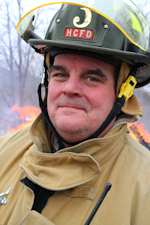FHWorld17: Changing Fire Dept. Culture Isn't Always Easy
SAN DIEGO—When a line-of-duty death (LODD) hit a southern Illinois fire department, one fire officer said it felt like someone had taken the tablecloth on their place setting and yanked it out leaving a jumbled array of dishes and utensils that barely resembled how it looked before.
Brian Brauer, associate director of the University of Illinois Fire Service Institute (IFSI), presented a case study of that fire department, which he deliberately did not name, at a Firehouse World session. Brauer did the study for an academic dissertation and is sharing it with other firefighters so they may benefit from the lessons learned.
The firefighter, after being ordered away from the building, was killed by a collapse after trying to retrieve a ladder leaning against the compromised masonry commercial building. Brauer said he wanted to examine a fire department that had experienced a tragedy and see how that event changed the culture of the department. The title of the class was: “Changing Fire Department Organizational Culture: A Case Study.”
During his presentation, Brauer said while it is possible to change the culture of a fire department, it is next to impossible to change people’s core values.
“If you have a firefighter who isn’t willing to give his life for another, there is no way you can change that,” Brauer said, noting that departments might need to rethink whether that person should be serving on the department.
When trying to build a cultural change within a department, Brauer said leaders need to guard against rewarding behavior that doesn’t meet expectations of the department’s standard operational guidelines (SOGs). Fire department often reward firefighters who run into burning buildings without their PPE to save a life, but Brauer warned that fire departments have to be careful with that kind of reward system.
“Do we give half a medal for doing things the wrong way?” he asked, rhetorically.
Following SOGs and routines are good for firefighters, Brauer said. A routine takes away decision-making and reduces decision fatigue, he explained.
“Part of our human programming is we get tired of making decisions,” Brauer said, adding that the default to decision-making is status quo. And that default is not always good, he said, because firefighting is inherently risky and firefighters need to be ready for that ever changing environment.
“In other occupations, they are able to manage and control 100 percent of the risk,” he said. In firefighting, he added, it’s difficult to control any of the risk.
In his case study of the department, Bauer looked for all these elements of the firefighting culture. During the interviewing of department members, the reading of reports and news accounts, he determined the department made 28 significant changes in the way it operates.
Those changes can be attributed primarily to changes in leadership, Brauer said. Prior to the LODD, the department’s officers were selected by attrition; the ones who lasted longest became the officers, without much regard for the qualifications of the individual.
With the change in leadership, the department was able to focus on things like training, which gave the department a big boost in its Insurance Service Office (ISO) rating, moving it from a Class 7 to a “solid Class 4” department, Brauer said.
There are three primary areas for ISO: water supply, dispatch and communications and training, and they focused on training to improve the rating, he said.
“These changes didn’t happen overnight,” Brauer said. “In fact, change was already in place before the LODD.”
He said many of the department members knew change was needed, but they didn’t know how to do it. In many ways, Brauer said, the LODD became the catalyst for the much-needed changes within the department.
“Change can happen,” Brauer said. “Be sure your members understand why the changes are needed and be patient.”

Ed Ballam
Ed Ballam served as associate editor for Firehouse. He is the assistant chief of the Haverhill Corner, N.H. Fire Department, and a National Registered EMT. He is also a Deputy Forest Fire Warden for the New Hampshire Division of Forests and Lands. Professionally, he's been a journalist for over 35 years working for a variety of publications, including employment as managing editor of a national fire service trade journal for more than a decade.






